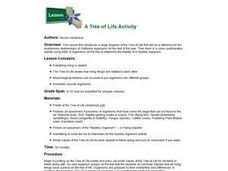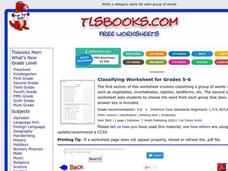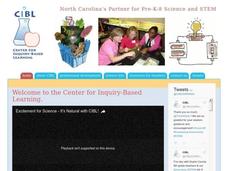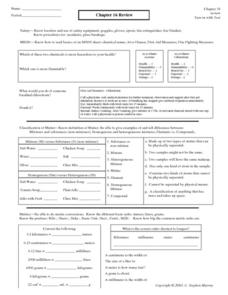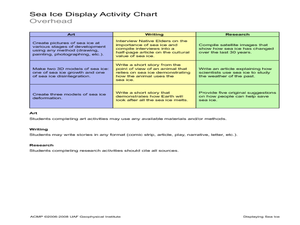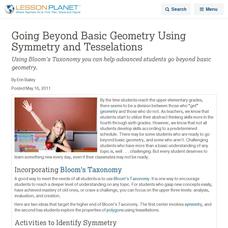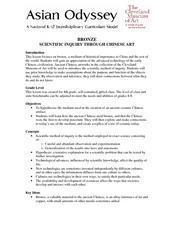Curated OER
Community Journals
Students visit a multimedia online journal as a model for their research and journal about their own communities. They examine writing for themselves and writing for an audience as they study the community and present it in more than one...
Curated OER
Types of Matter
Students analyze different types of matter according to its general and specific properties. They design an experiment to classify matter. Students are shown cornflakes and raisins. They are asked what type of substance is each...
Curated OER
A Tree of Life Activity
High schoolers solve a mystery of the identification of a unknown organism by comparing its morphological characteristics to those in a tree of life classification poster. They compare the observable characteristics of the specimen and...
Curated OER
Classifying
In this classifying worksheet, students observe a group of words, analyze their similar characteristics and then give them a classification. Groups of words include items such as vegetables, reptiles, landforms, conifer trees,...
Curated OER
The Mystery Box
Learners work in groups with a wooden box that is sealed shut. They make predictions about what is inside the box. Before being allowed to open the box, the groups make hypotheses, conduct experiements, record results, draw conclusions,...
Curated OER
Inventing and Presenting Unit 3: Persuasive Speaking and Invention Promotion
Middle schoolers write a proposal for a speech. Students prepare appropriate visuals for use in the proposed speech. Middle schoolers produce one or more graphs that summarize the results from the experimentation. Students deliver an...
Curated OER
Centrifugal Force and Mandy Sue Day
Fourth graders explore the story Mandy Sue Day and investigate centrifugal force. They demonstrate the concept of centrifugal force, use analytical thinking and they conduct an experiment using centrifugal force. Students discuss the...
Curated OER
How Does Light Travel
Seventh graders design an experiment to determine how light travels. For this physics lesson, 7th graders collect and analyze data. They formulate a conclusion and share results with the class.
Curated OER
Chapter 16 Review- General Science
For this review of general science worksheet, students classify examples of matter as mixtures or substances, homogeneous or heterogeneous mixtures, or elements or compounds. Students also convert several examples using the standard...
Curated OER
Combining Elements to Form a Compound
Students explore elements and compounds. In this lesson about elements and compounds, students will do an experiment. Students work in groups of 2-3 as they complete two separate activities. Students understand how two elements combine...
Curated OER
Cooperative Learning Experience Through the Flipping Lid Demo
Students create a cartoon illustrating a lab demonstration. In this lab safety lesson, the teacher demonstrates a small methane explosion to demonstrate the importance of safety in a laboratory setting, then students work in groups to...
Curated OER
Displaying Sea Ice
Students display their knowledge of sea ice. In this earth science lesson, students create displays reflecting their understanding of sea ice.Students research the development of sea ice on a variety of bodies of water, and use proper...
Curated OER
Making a Crater
Learners examine the characteristics of craters. In this crater lesson, students discover how meteors form craters on planets and moons as they make their own craters and respond to observational questions regarding the scientific...
Curated OER
The Button Box
Students classify buttons. In this classification instructional activity, students listen to the book The Button Box by Margarette S. Reid before observing, describing and classifying real buttons.
Curated OER
Earth's Hydrologic Cycle
Students examine the water cycle. In this hydrologic cycle lesson, students follow the provided procedures to demonstrate the how water moves around the planet through the dynamics of the water cycle.
Curated OER
Identifying Creatures
Young scholars use a classification key from a provided worksheet to identify creatures. This task assesses student's abilities to interpret data, make decisions, identify, and classify.
Curated OER
Wonderful Waves
In this science worksheet, students perform an investigation about sound waves and vibration. Students use a pan of water and toothpicks to make and observe ripples. Students answer 4 essay questions about their observations.
Curated OER
Galapagos Adaptations
Students examine photographs of closely related species found in the Gal??pagos environment, observe differences and similarities between species, and form hypotheses about species differences and the relationship to the environment of...
Curated OER
Weather Journal
Sixth graders write in a journal using weather observations as the focus, they develop writing techniques in addition to scientific observation skills.
Curated OER
Scientific Inquiry
Middle schoolers make inferences about what activities occur at different places in school. They form a hypothesis as to how space is used. They simulate how archeaologists explore past people by designing and conducting a research project.
Curated OER
Observation of a Living Earthworm
Sixth graders examine earthworms and their parts. In this earthworm activity students complete a lab worksheet on the earthworm and test its response to certain factors.
Curated OER
Going Beyond Basic Geometry Using Symmetry and Tesselations
Using Bloom's Taxonomy you can help advanced students go beyond basic geometry.
Curated OER
Open-Ended Scientific Method Lab
Learners inspect a given problem and come up with a hypothesis. In this investigative lesson students come up with a hypothesis for a problem, test each hypothesis and evaluate how successful each one was.
Curated OER
Bronze: Scientific Inquiry through Chinese Art
Learners examine the use of bronze and porcelain in Chinese art and commerce through in-class activities, role play events, and small-group discussions in this exciting Social Studies/Arts instructional activity.




